python之常用模块
一、模块的定义
1.1 什么是模块
常见的场景:一个模块就是一个包含了python定义和声明的文件,文件名就是模块名字加上.py的后缀
但其实import加载的模块分为四个通用类别:
- 使用python编写的代码(.py文件)
- 已被便以为共享库或DLL的C或C++扩展
- 包好一组模块的包
- 使用C编写并链接到python解释器的内置模块
1.2 为何要使用模块
如果你退出python解释器然后重新进入,那么你之前定义的函数或者变量豆浆丢失,因此我们通常将程序学到文件中一边永久保存下来,需要时就通过python test.py方式去执行,此时test.py被称为脚本script。
随着程序的发展,功能越来越多,为了方便管理,我们通常将程序分成一个个的文件,这样做程序的结构更清晰,方便管理。这时我们不仅仅可以把这些文件当做脚本去执行,还可以把他们当做模块来导入到其他的模块中,实现了功能的重复利用
二、常用模块
1. collections模块
在内置数据类型(dict,list,set,tuple)的基础上,collection模块还提供了几个额外的数据类型:Counter,Deque,defaultdict,namedtuple和OrderdDict等。
- namedtuple:生成可以使用名字来访问元素内容的tuple
- deque:双端队列,可以快速的从另外一侧追加和推出对象
- Counter:计数器,主要用来计数
- OrderdDict:有序字典
- defaultdict:带有默认值的字典
1.1 namedtuple
我们知道tuple可以代表不变集合,例如 ,一个点的二维坐标就可以表示成:
p = (1,2)
但是,看到(1,2),很难看出这个tuple是用来表示一个坐标的
这时,namedtuple就派上用场了:
from collections import namedtuple Point = namedtuple('Point',['x','y']) p = Point(1,2) print (p.x)
类似的,如果要用坐标和半径表示一个圆,也可以用namedtuple定义:
#namedtuple('名称', [属性list]): Circle = namedtuple('Circle', ['x', 'y', 'r'])
1.2 deque
使用list存储数据时,按索引访问元素很快,但是插入和删除元素就很慢了,因为list是线性存储,数据量大的时候,插入和删除的效率很低。
deque是为了高效实现插入和删除操作的双向列表,适合于队列和栈:
from collections import deque q = deque(['a', 'b', 'c']) q.append('x') q.appendleft('y') print(q) #deque(['y', 'a', 'b', 'c', 'x'])
deque除了实现list的append()和pop()外,还支持appendleft()和popleft(),这样就可以非常高效的往头部添加或删除元素。
1.3 OrderdDict
使用dict时,key是无序的。在对dict做迭代时,我们无法雀东key的顺序
如果要保持key的顺序,可以用OrderdDict:
from collections import OrderedDict d = dict([('a', 1), ('b', 2), ('c', 3)]) print(d) # dict的Key是无序的 # {'a': 1, 'c': 3, 'b': 2} od = OrderedDict([('a', 1), ('b', 2), ('c', 3)]) print(od) # OrderedDict的Key是有序的 # OrderedDict([('a', 1), ('b', 2), ('c', 3)
注意,OrderdDict的key会按照插入的顺序排列,不是key本身排序:
od = OrderedDict() od['z'] = 1 od['y'] = 2 od['x'] = 3 print(od.keys()) # 按照插入的Key的顺序返回 # ['z', 'y', 'x']
1.4 defautdict
有如下值集合[11,22,33,44,55,66,77,88,99,90...],将所有大于66的值保存至字典的第一个key中,将小于66的值保存至第二个key的值中。

1 values = [11, 22, 33,44,55,66,77,88,99,90] 2 3 my_dict = {} 4 5 for value in values: 6 if value>66: 7 if my_dict.has_key('k1'): 8 my_dict['k1'].append(value) 9 else: 10 my_dict['k1'] = [value] 11 else: 12 if my_dict.has_key('k2'): 13 my_dict['k2'].append(value) 14 else: 15 my_dict['k2'] = [value] 16 17 原生字典解决方法

1 from collections import defaultdict 2 3 values = [11, 22, 33,44,55,66,77,88,99,90] 4 5 my_dict = defaultdict(list) 6 7 for value in values: 8 if value>66: 9 my_dict['k1'].append(value) 10 else: 11 my_dict['k2'].append(value) 12 13 defaultdict字典解决方法
使用dict时,如果引用的key不存在,就会跑出keyError,如果希望key不存在时,返回一个默认值,就可以用defautdict:

1 from collections import defaultdict 2 dd = defaultdict(lambda: 'N/A') 3 dd['key1'] = 'abc' 4 print(dd['key1'] )# key1存在 5 'abc' 6 print(dd['key2']) # key2不存在,返回默认值 7 'N/A'
1.5 Counter
Counter类的目的是用来跟踪值出现的次数,他是一个无序的容器类型,以字典的键值对形式存储,其中元素作为key,其计数作为value,计数值可以使任意的Interger(包括0和负数)。Counter类和其他语言的bags或multisets很相似
from collections import Counter c = Counter('abcdeabcdabcaba') print (c) 输出:Counter({'a': 5, 'b': 4, 'c': 3, 'd': 2, 'e': 1})
2. 时间模块
2.1 和时间有关系的我们就要用到时间模块。在使用模块之前,应该首先导入这个模块。
#常用方法 1.time.sleep(secs) (线程)推迟指定的时间运行。单位为秒。 2.time.time() 获取当前时间戳
2.2 表示时间的三种方式
在python中,通常有这三种方式来表示时间: 时间戳, 元组(struct_time)、格式化的时间字符串:
- 时间戳(timestamp):通常来说,时间戳表示的是从1970年1月1日00:00:00开始按秒计算的偏移量,我们运行'type(time.time())',返回的是float类型
- 格式化的时间字符串(Format String):‘1999-12-06’
 View Code
View Code1 %y 两位数的年份表示(00-99) 2 %Y 四位数的年份表示(000-9999) 3 %m 月份(01-12) 4 %d 月内中的一天(0-31) 5 %H 24小时制小时数(0-23) 6 %I 12小时制小时数(01-12) 7 %M 分钟数(00=59) 8 %S 秒(00-59) 9 %a 本地简化星期名称 10 %A 本地完整星期名称 11 %b 本地简化的月份名称 12 %B 本地完整的月份名称 13 %c 本地相应的日期表示和时间表示 14 %j 年内的一天(001-366) 15 %p 本地A.M.或P.M.的等价符 16 %U 一年中的星期数(00-53)星期天为星期的开始 17 %w 星期(0-6),星期天为星期的开始 18 %W 一年中的星期数(00-53)星期一为星期的开始 19 %x 本地相应的日期表示 20 %X 本地相应的时间表示 21 %Z 当前时区的名称 22 %% %号本身 23 24 python中时间日期格式化符号:
- 元组(struct_time) :struct_time元组共有9个元素:(年,月,日,时,分,秒,一年中第几周,一年中第几天等)
首先,我们先导入time 模块,来认识一下python中表示时间的几种格式
import time #时间戳 print(time.time()) #时间字符串 print(time.strftime("%Y-%m-%d %X")) print(time.strftime("%Y-%m-%d %H-%M-%S")) #时间元组:localtime将一个时间戳转换为当前时区的struct_time print(time.localtime())
小结:时间戳是计算机能够识别的时间;时间字符串是人能够看懂的时间;元组则是用来操作时间的
几种格式之间的转换

1 # 结构化时间 --> 格式化时间 2 # ftime = time.strftime('%Y-%m-%d %H:%M:%S',stime) 3 # print(ftime) 4 # 5 # s_time= time.strptime('2065-01-24 13:20:00','%Y-%m-%d %H:%M:%S') 6 # print(s_time) 7 8 # print(time.asctime(time.localtime(3000000000))) 9 10 # print(time.ctime(3000000000)) 11 12 #发布信息的时候记录一个时间戳 13 #用现在的时间和之前的时间戳做计算 14 # 现在的时间戳 - 之前的时间戳 = 时间戳的差 15 # 时间戳的差 转换成 结构化时间 16 # 结构化时间 - 1970-1-1 0:0:0 17 18 # 结构化时间 = time.strptime('2018-2-28 22:29:30','%Y-%m-%d %H:%M:%S') 19 # 结构化时间2 = time.strptime('2018-3-1 10:28:02','%Y-%m-%d %H:%M:%S') 20 # 时间戳时间 = time.mktime(结构化时间) 21 # 时间戳时间2 = time.mktime(结构化时间2) 22 # 23 # 时间戳时间的差 = 时间戳时间2 - 时间戳时间 24 # print(时间戳时间的差) 25 # 26 # 结构化时间差 = time.gmtime(时间戳时间的差) 27 # 28 # print(结构化时间差.tm_year-1970,结构化时间差.tm_mon - 1, 29 # 结构化时间差.tm_mday-1,结构化时间差.tm_hour - 0, 30 # 结构化时间差.tm_min-0,结构化时间差.tm_sec-0)
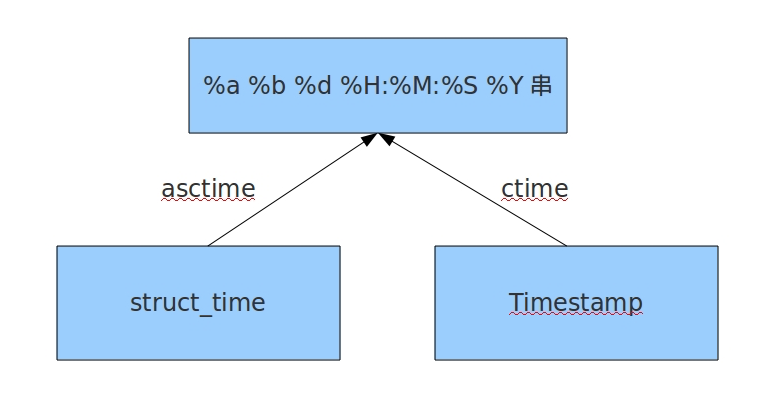
3. random模块

1 import random 2 # print(random.choice([1,'23',[4,5]])) 3 # print(random.sample([1,'23',[4,5]],2)) 4 5 # 排序 10000 6 # item = [1,3,5,7,9] 7 # random.shuffle(item) 8 # print(item) 9 # 随机验证码 数字+字母 10 # import random 11 # num_alpha_lst = [] 12 # for i in range(10): 13 # num_alpha_lst.append(i) 14 # for i in range(65,91): 15 # num_alpha_lst.append(chr(i)) 16 # code = '' 17 # for i in range(6): 18 # c = random.choice(num_alpha_lst) 19 # code += str(c) 20 # print(code) 21 # [num,alpha] 10+26 = 36*6* 22 # sample # 6 23 # choice # 1

1 # 先从数字中选一个数 2 # 再从字母中选一个字母 3 # 从这个数字和字母中随机选一个 4 import random 5 def v_code(): 6 code = '' 7 for i in range(5): 8 num=random.randint(0,9) 9 alf=chr(random.randint(65,90)) 10 add=random.choice([num,alf]) 11 code="".join([code,str(add)]) 12 return code 13 print(v_code())
4. os模块
os模块是与操作系统交互的一个接口

1 ''' 2 os.getcwd() 获取当前工作目录,即当前python脚本工作的目录路径 3 os.chdir("dirname") 改变当前脚本工作目录;相当于shell下cd 4 os.curdir 返回当前目录: ('.') 5 os.pardir 获取当前目录的父目录字符串名:('..') 6 os.makedirs('dirname1/dirname2') 可生成多层递归目录 7 os.removedirs('dirname1') 若目录为空,则删除,并递归到上一级目录,如若也为空,则删除,依此类推 8 os.mkdir('dirname') 生成单级目录;相当于shell中mkdir dirname 9 os.rmdir('dirname') 删除单级空目录,若目录不为空则无法删除,报错;相当于shell中rmdir dirname 10 os.listdir('dirname') 列出指定目录下的所有文件和子目录,包括隐藏文件,并以列表方式打印 11 os.remove() 删除一个文件 12 os.rename("oldname","newname") 重命名文件/目录 13 os.stat('path/filename') 获取文件/目录信息 14 os.sep 输出操作系统特定的路径分隔符,win下为"\\",Linux下为"/" 15 os.linesep 输出当前平台使用的行终止符,win下为"\t\n",Linux下为"\n" 16 os.pathsep 输出用于分割文件路径的字符串 win下为;,Linux下为: 17 os.name 输出字符串指示当前使用平台。win->'nt'; Linux->'posix' 18 os.system("bash command") 运行shell命令,直接显示 19 os.popen("bash command).read() 运行shell命令,获取执行结果 20 os.environ 获取系统环境变量 21 22 23 os.path 24 os.path.abspath(path) 返回path规范化的绝对路径 os.path.split(path) 将path分割成目录和文件名二元组返回 os.path.dirname(path) 返回path的目录。其实就是os.path.split(path)的第一个元素 os.path.basename(path) 返回path最后的文件名。如何path以/或\结尾,那么就会返回空值。 25 即os.path.split(path)的第二个元素 26 os.path.exists(path) 如果path存在,返回True;如果path不存在,返回False 27 os.path.isabs(path) 如果path是绝对路径,返回True 28 os.path.isfile(path) 如果path是一个存在的文件,返回True。否则返回False 29 os.path.isdir(path) 如果path是一个存在的目录,则返回True。否则返回False 30 os.path.join(path1[, path2[, ...]]) 将多个路径组合后返回,第一个绝对路径之前的参数将被忽略 31 os.path.getatime(path) 返回path所指向的文件或者目录的最后访问时间 32 os.path.getmtime(path) 返回path所指向的文件或者目录的最后修改时间 33 os.path.getsize(path) 返回path的大小 34 '''
注意:os.stat('path/filename') 获取文件/目录信息 的结构说明

1 stat 结构: 2 3 st_mode: inode 保护模式 4 st_ino: inode 节点号。 5 st_dev: inode 驻留的设备。 6 st_nlink: inode 的链接数。 7 st_uid: 所有者的用户ID。 8 st_gid: 所有者的组ID。 9 st_size: 普通文件以字节为单位的大小;包含等待某些特殊文件的数据。 10 st_atime: 上次访问的时间。 11 st_mtime: 最后一次修改的时间。 12 st_ctime: 由操作系统报告的"ctime"。在某些系统上(如Unix)是最新的元数据更改的时间,在其它系统上(如Windows)是创建时间(详细信息参见平台的文档)。
5. sys模块
sys模块是与python解释器交互的一个接口
sys.argv 命令行参数List,第一个元素是程序本身路径 sys.exit(n) 退出程序,正常退出时exit(0),错误退出sys.exit(1) sys.version 获取Python解释程序的版本信息 sys.path 返回模块的搜索路径,初始化时使用PYTHONPATH环境变量的值 sys.platform 返回操作系统平台名称

1 import sys 2 try: 3 sys.exit(1) 4 except SystemExit as e: 5 print(e)
6.序列化模块
6.1将原本的字典、列表等内容转换成一个字符串的过程就叫做序列化

1 比如,我们在python代码中计算的一个数据需要给另外一段程序使用,那我们怎么给? 2 现在我们能想到的方法就是存在文件里,然后另一个python程序再从文件里读出来。 3 但是我们都知道,对于文件来说是没有字典这个概念的,所以我们只能将数据转换成字典放到文件中。 4 你一定会问,将字典转换成一个字符串很简单,就是str(dic)就可以办到了,为什么我们还要学习序列化模块呢? 5 没错序列化的过程就是从dic 变成str(dic)的过程。现在你可以通过str(dic),将一个名为dic的字典转换成一个字符串, 6 但是你要怎么把一个字符串转换成字典呢? 7 聪明的你肯定想到了eval(),如果我们将一个字符串类型的字典str_dic传给eval,就会得到一个返回的字典类型了。 8 eval()函数十分强大,但是eval是做什么的?e官方demo解释为:将字符串str当成有效的表达式来求值并返回计算结果。 9 BUT!强大的函数有代价。安全性是其最大的缺点。 10 想象一下,如果我们从文件中读出的不是一个数据结构,而是一句"删除文件"类似的破坏性语句,那么后果实在不堪设设想。 11 而使用eval就要担这个风险。 12 所以,我们并不推荐用eval方法来进行反序列化操作(将str转换成python中的数据结构) 13 14 为什么要有序列化模块
6.2 序列化的目的。
- 以某种存储形式使自定义对象持久化
- 将对象从一个地方传递到另一个地方
- 使程序更具维护性
7. json&pickle模块
7.1 json模块提供了四个功能: dumps,dump,loads,load

1 import json 2 dic = {'k1':'v1','k2':'v2','k3':'v3'} 3 str_dic = json.dumps(dic) #序列化:将一个字典转换成一个字符串 4 print(type(str_dic),str_dic) #<class 'str'> {"k3": "v3", "k1": "v1", "k2": "v2"} 5 #注意,json转换完的字符串类型的字典中的字符串是由""表示的 6 7 dic2 = json.loads(str_dic) #反序列化:将一个字符串格式的字典转换成一个字典 8 #注意,要用json的loads功能处理的字符串类型的字典中的字符串必须由""表示 9 print(type(dic2),dic2) #<class 'dict'> {'k1': 'v1', 'k2': 'v2', 'k3': 'v3'} 10 11 12 list_dic = [1,['a','b','c'],3,{'k1':'v1','k2':'v2'}] 13 str_dic = json.dumps(list_dic) #也可以处理嵌套的数据类型 14 print(type(str_dic),str_dic) #<class 'str'> [1, ["a", "b", "c"], 3, {"k1": "v1", "k2": "v2"}] 15 list_dic2 = json.loads(str_dic) 16 print(type(list_dic2),list_dic2) #<class 'list'> [1, ['a', 'b', 'c'], 3, {'k1': 'v1', 'k2': 'v2'}]

1 import json 2 f = open('json_file','w') 3 dic = {'k1':'v1','k2':'v2','k3':'v3'} 4 json.dump(dic,f) #dump方法接收一个文件句柄,直接将字典转换成json字符串写入文件 5 f.close() 6 7 f = open('json_file') 8 dic2 = json.load(f) #load方法接收一个文件句柄,直接将文件中的json字符串转换成数据结构返回 9 f.close()

1 import json 2 f = open('file','w') 3 json.dump({'国籍':'中国'},f) 4 ret = json.dumps({'国籍':'中国'}) 5 f.write(ret+'\n') 6 json.dump({'国籍':'美国'},f,ensure_ascii=False) 7 ret = json.dumps({'国籍':'美国'},ensure_ascii=False) 8 f.write(ret+'\n') 9 f.close()

1 Serialize obj to a JSON formatted str.(字符串表示的json对象) 2 Skipkeys:默认值是False,如果dict的keys内的数据不是python的基本类型(str,unicode,int,long,float,bool,None),设置为False时,就会报TypeError的错误。此时设置成True,则会跳过这类key 3 ensure_ascii:,当它为True的时候,所有非ASCII码字符显示为\uXXXX序列,只需在dump时将ensure_ascii设置为False即可,此时存入json的中文即可正常显示。) 4 If check_circular is false, then the circular reference check for container types will be skipped and a circular reference will result in an OverflowError (or worse). 5 If allow_nan is false, then it will be a ValueError to serialize out of range float values (nan, inf, -inf) in strict compliance of the JSON specification, instead of using the JavaScript equivalents (NaN, Infinity, -Infinity). 6 indent:应该是一个非负的整型,如果是0就是顶格分行显示,如果为空就是一行最紧凑显示,否则会换行且按照indent的数值显示前面的空白分行显示,这样打印出来的json数据也叫pretty-printed json 7 separators:分隔符,实际上是(item_separator, dict_separator)的一个元组,默认的就是(‘,’,’:’);这表示dictionary内keys之间用“,”隔开,而KEY和value之间用“:”隔开。 8 default(obj) is a function that should return a serializable version of obj or raise TypeError. The default simply raises TypeError. 9 sort_keys:将数据根据keys的值进行排序。 10 To use a custom JSONEncoder subclass (e.g. one that overrides the .default() method to serialize additional types), specify it with the cls kwarg; otherwise JSONEncoder is used.

1 import json 2 data = {'username':['李华','二愣子'],'sex':'male','age':16} 3 json_dic2 = json.dumps(data,sort_keys=True,indent=2,separators=(',',':'),ensure_ascii=False) 4 print(json_dic2)
7.2 pickle模块提供了四个功能: dumps,dump(序列化,存),loads(反序列化,读),load(不仅可以序列化列表,字典...可以把python中的任意的数据类型序列化)

1 import pickle 2 dic = {'k1':'v1','k2':'v2','k3':'v3'} 3 str_dic = pickle.dumps(dic) 4 print(str_dic) #一串二进制内容 5 6 dic2 = pickle.loads(str_dic) 7 print(dic2) #字典 8 9 import time 10 struct_time = time.localtime(1000000000) 11 print(struct_time) 12 f = open('pickle_file','wb') 13 pickle.dump(struct_time,f) 14 f.close() 15 16 f = open('pickle_file','rb') 17 struct_time2 = pickle.load(f) 18 print(struct_time2.tm_year)
7.3 json&pickle模块是用于序列化的两个模块
- json,用于字符串和python数据类型之间进行转换
- pickle,用于python特有的类型和python的数据类型之间进行转换
8. shelve模块
shelve也是python提供给我们的序列化工具,比pickle用起来更简单一些。
shelve只提供给我们一个open方法,是用key来访问的,使用起来和字典类似。

1 import shelve 2 f = shelve.open('shelve_file') 3 f['key'] = {'int':10, 'float':9.5, 'string':'Sample data'} #直接对文件句柄操作,就可以存入数据 4 f.close() 5 6 import shelve 7 f1 = shelve.open('shelve_file') 8 existing = f1['key'] #取出数据的时候也只需要直接用key获取即可,但是如果key不存在会报错 9 f1.close() 10 print(existing)
这个模块有个限制,它不支持多个应用同一时间往同一个DB进行写操作。所以当我们知道我们的应用如果只进行读操作,我们可以让shelve通过只读方式打开DB

1 import shelve 2 f = shelve.open('shelve_file', flag='r') 3 existing = f['key'] 4 f.close() 5 print(existing)
由于shelve在默认情况下是不会记录待持久化对象的任何修改的,所以我们在shelve.open()时候需要修改默认参数,否则对象的修改不会保存。

1 import shelve 2 f1 = shelve.open('shelve_file') 3 print(f1['key']) 4 f1['key']['new_value'] = 'this was not here before' 5 f1.close() 6 7 f2 = shelve.open('shelve_file', writeback=True) 8 print(f2['key']) 9 f2['key']['new_value'] = 'this was not here before' 10 f2.close()
writeback方式有优点也有缺点。优点是减少了我们出错的概率,并且让对象的持久化对用户更加的透明了;但这种方式并不是所有的情况下都需要,首先,使用writeback以后,shelf在open()的时候会增加额外的内存消耗,并且当DB在close()的时候会将缓存中的每一个对象都写入到DB,这也会带来额外的等待时间。因为shelve没有办法知道缓存中哪些对象修改了,哪些对象没有修改,因此所有的对象都会被写入。writeback方式有优点也有缺点。优点是减少了我们出错的概率,并且让对象的持久化对用户更加的透明了;但这种方式并不是所有的情况下都需要,首先,使用writeback以后,shelf在open()的时候会增加额外的内存消耗,并且当DB在close()的时候会将缓存中的每一个对象都写入到DB,这也会带来额外的等待时间。因为shelve没有办法知道缓存中哪些对象修改了,哪些对象没有修改,因此所有的对象都会被写入。
9. re模块
9.1 正则表达式在线测试工具: http://tool.chinaz.com/regex/

字符: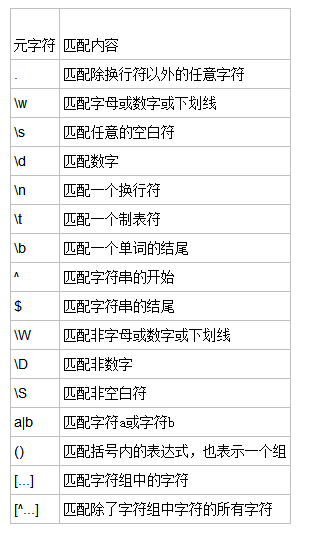
量词: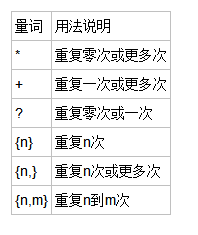
.^$: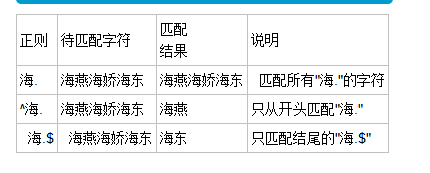
*+?{}:
字符集[] [^]: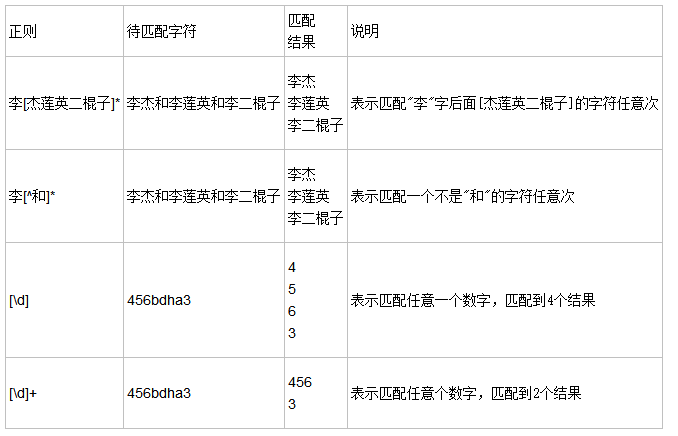
分组()与 或 | [^]: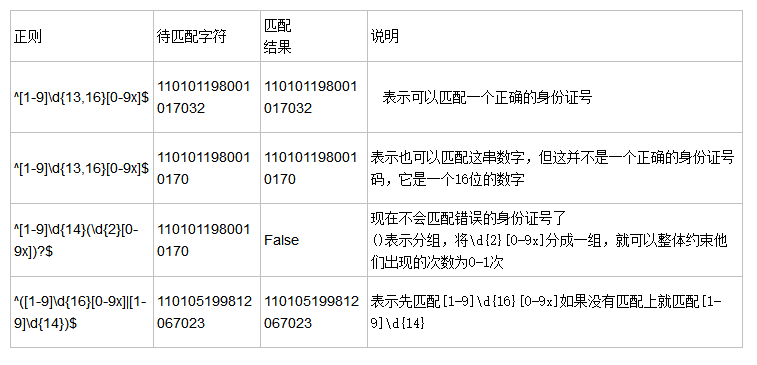
转义符\ :
贪婪匹配:
9.2 re模块 常用方法

1 import re 2 3 ret = re.findall('a', 'eva egon yuan') # 返回所有满足匹配条件的结果,放在列表里 4 print(ret) #结果 : ['a', 'a'] 5 6 ret = re.search('a', 'eva egon yuan').group() 7 print(ret) #结果 : 'a' 8 # 函数会在字符串内查找模式匹配,只到找到第一个匹配然后返回一个包含匹配信息的对象,该对象可以 9 # 通过调用group()方法得到匹配的字符串,如果字符串没有匹配,则返回None。 10 11 ret = re.match('a', 'abc').group() # 同search,不过尽在字符串开始处进行匹配 12 print(ret) 13 #结果 : 'a' 14 15 ret = re.split('[ab]', 'abcd') # 先按'a'分割得到''和'bcd',在对''和'bcd'分别按'b'分割 16 print(ret) # ['', '', 'cd'] 17 18 ret = re.sub('\d', 'H', 'eva3egon4yuan4', 1)#将数字替换成'H',参数1表示只替换1个 19 print(ret) #evaHegon4yuan4 20 21 ret = re.subn('\d', 'H', 'eva3egon4yuan4')#将数字替换成'H',返回元组(替换的结果,替换了多少次) 22 print(ret) 23 24 obj = re.compile('\d{3}') #将正则表达式编译成为一个 正则表达式对象,规则要匹配的是3个数字 25 ret = obj.search('abc123eeee') #正则表达式对象调用search,参数为待匹配的字符串 26 print(ret.group()) #结果 : 123 27 28 import re 29 ret = re.finditer('\d', 'ds3sy4784a') #finditer返回一个存放匹配结果的迭代器 30 print(ret) # <callable_iterator object at 0x10195f940> 31 print(next(ret).group()) #查看第一个结果 32 print(next(ret).group()) #查看第二个结果 33 print([i.group() for i in ret]) #查看剩余的左右结果
注意:
1.findall 优先级查询

1 import re 2 3 ret = re.findall('www.(baidu|oldboy).com', 'www.oldboy.com') 4 print(ret) # ['oldboy'] 这是因为findall会优先把匹配结果组里内容返回,如果想要匹配结果,取消权限即可 5 6 ret = re.findall('www.(?:baidu|oldboy).com', 'www.oldboy.com') 7 print(ret) # ['www.oldboy.com']
2.spilt优先级查询

1 ret=re.split("\d+","eva3egon4yuan") 2 print(ret) #结果 : ['eva', 'egon', 'yuan'] 3 4 ret=re.split("(\d+)","eva3egon4yuan") 5 print(ret) #结果 : ['eva', '3', 'egon', '4', 'yuan'] 6 7 #在匹配部分加上()之后所切出的结果是不同的, 8 #没有()的没有保留所匹配的项,但是有()的却能够保留了匹配的项, 9 #这个在某些需要保留匹配部分的使用过程是非常重要的。
9.3 练习
1. 匹配标签

1 import re 2 3 4 ret = re.search("<(?P<tag_name>\w+)>\w+</(?P=tag_name)>","<h1>hello</h1>") 5 #还可以在分组中利用?<name>的形式给分组起名字 6 #获取的匹配结果可以直接用group('名字')拿到对应的值 7 print(ret.group('tag_name')) #结果 :h1 8 print(ret.group()) #结果 :<h1>hello</h1> 9 10 ret = re.search(r"<(\w+)>\w+</\1>","<h1>hello</h1>") 11 #如果不给组起名字,也可以用\序号来找到对应的组,表示要找的内容和前面的组内容一致 12 #获取的匹配结果可以直接用group(序号)拿到对应的值 13 print(ret.group(1)) 14 print(ret.group()) #结果 :<h1>hello</h1>
2.匹配整数

1 import re 2 3 ret=re.findall(r"\d+","1-2*(60+(-40.35/5)-(-4*3))") 4 print(ret) #['1', '2', '60', '40', '35', '5', '4', '3'] 5 ret=re.findall(r"-?\d+\.\d*|(-?\d+)","1-2*(60+(-40.35/5)-(-4*3))") 6 print(ret) #['1', '-2', '60', '', '5', '-4', '3'] 7 ret.remove("") 8 print(ret) #['1', '-2', '60', '5', '-4', '3']
3.数字匹配

1、 匹配一段文本中的每行的邮箱 http://blog.csdn.net/make164492212/article/details/51656638 2、 匹配一段文本中的每行的时间字符串,比如:‘1990-07-12’; 分别取出1年的12个月(^(0?[1-9]|1[0-2])$)、 一个月的31天:^((0?[1-9])|((1|2)[0-9])|30|31)$ 3、 匹配qq号。(腾讯QQ号从10000开始) [1,9][0,9]{4,} 4、 匹配一个浮点数。 ^(-?\d+)(\.\d+)?$ 或者 -?\d+\.?\d* 5、 匹配汉字。 ^[\u4e00-\u9fa5]{0,}$ 6、 匹配出所有整数
4.爬虫练习

1 import requests 2 3 import re 4 import json 5 6 def getPage(url): 7 8 response=requests.get(url) 9 return response.text 10 11 def parsePage(s): 12 13 com=re.compile('<div class="item">.*?<div class="pic">.*?<em .*?>(?P<id>\d+).*?<span class="title">(?P<title>.*?)</span>' 14 '.*?<span class="rating_num" .*?>(?P<rating_num>.*?)</span>.*?<span>(?P<comment_num>.*?)评价</span>',re.S) 15 16 ret=com.finditer(s) 17 for i in ret: 18 yield { 19 "id":i.group("id"), 20 "title":i.group("title"), 21 "rating_num":i.group("rating_num"), 22 "comment_num":i.group("comment_num"), 23 } 24 25 def main(num): 26 27 url='https://movie.douban.com/top250?start=%s&filter='%num 28 response_html=getPage(url) 29 ret=parsePage(response_html) 30 print(ret) 31 f=open("move_info7","a",encoding="utf8") 32 33 for obj in ret: 34 print(obj) 35 data=json.dumps(obj,ensure_ascii=False) 36 f.write(data+"\n") 37 38 if __name__ == '__main__': 39 count=0 40 for i in range(10): 41 main(count) 42 count+=25

1 import re 2 import json 3 from urllib.request import urlopen 4 5 def getPage(url): 6 response = urlopen(url) 7 return response.read().decode('utf-8') 8 9 def parsePage(s): 10 com = re.compile( 11 '<div class="item">.*?<div class="pic">.*?<em .*?>(?P<id>\d+).*?<span class="title">(?P<title>.*?)</span>' 12 '.*?<span class="rating_num" .*?>(?P<rating_num>.*?)</span>.*?<span>(?P<comment_num>.*?)评价</span>', re.S) 13 14 ret = com.finditer(s) 15 for i in ret: 16 yield { 17 "id": i.group("id"), 18 "title": i.group("title"), 19 "rating_num": i.group("rating_num"), 20 "comment_num": i.group("comment_num"), 21 } 22 23 24 def main(num): 25 url = 'https://movie.douban.com/top250?start=%s&filter=' % num 26 response_html = getPage(url) 27 ret = parsePage(response_html) 28 print(ret) 29 f = open("move_info7", "a", encoding="utf8") 30 31 for obj in ret: 32 print(obj) 33 data = str(obj) 34 f.write(data + "\n") 35 36 count = 0 37 for i in range(10): 38 main(count) 39 count += 25

1 flags有很多可选值: 2 3 re.I(IGNORECASE)忽略大小写,括号内是完整的写法 4 re.M(MULTILINE)多行模式,改变^和$的行为 5 re.S(DOTALL)点可以匹配任意字符,包括换行符 6 re.L(LOCALE)做本地化识别的匹配,表示特殊字符集 \w, \W, \b, \B, \s, \S 依赖于当前环境,不推荐使用 7 re.U(UNICODE) 使用\w \W \s \S \d \D使用取决于unicode定义的字符属性。在python3中默认使用该flag 8 re.X(VERBOSE)冗长模式,该模式下pattern字符串可以是多行的,忽略空白字符,并可以添加注释
三、常用模块二
1. hashlib 模块

1 # 摘要算法 2 # a = alex3714 ===摘要==> 174692740812ab238919 3 # alex3714 ===摘要==> 174692740812ab238919 4 5 # 登录 md5 sha 6 # 密码不能使用明文存储 7 # 密文存储 摘要算法 8 # 校验文件一致性 md5 9 # 网络的上传下载 10 # 保证多台机器状态的一致 11 12 import hashlib 13 # md5_obj = hashlib.md5() 14 # # md5算法的对象 15 # md5_obj.update(b'alex3714') # 使用md5摘要算法对'alex3714'进行摘要 16 # res = md5_obj.hexdigest() # 获取摘要之后的结果 17 # print(res,type(res)) #aee949757a2e698417463d47acac93df 32位 18 19 # user = input('user : ') 20 # passwd = input('passwd : ') 21 # md5_obj = hashlib.md5() 22 # md5_obj.update(passwd.encode('utf-8')) 23 # passwd = md5_obj.hexdigest() 24 # if user == 'alex' and passwd == 'aee949757a2e698417463d47acac93df': 25 # print('登陆成功') 26 27 # md5_obj = hashlib.sha1() 28 # # md5算法的对象 29 # md5_obj.update(b'alex3714') # 使用md5摘要算法对'alex3714'进行摘要 30 # res = md5_obj.hexdigest() # 获取摘要之后的结果 31 # print(res) #8a003668a9c990f15148f9e4046e1410781533b6 40 32 33 # 相同的字符串使用相同的算法 在任何时候 得到的结果都是一致的 34 35 36 # 全世界的md5算法都是一样的 37 # 123456 111111 38 # md5_obj = hashlib.md5() 39 # md5算法的对象 40 # md5_obj.update(b'123456') # 使用md5摘要算法对'alex3714'进行摘要 41 # res = md5_obj.hexdigest() # 获取摘要之后的结果 42 # print(res,type(res)) #aee949757a2e698417463d47acac93df 32位 43 # 123456 e10adc3949ba59abbe56e057f20f883e 44 # 撞库 45 46 # 加盐 47 md5_obj = hashlib.md5('盐'.encode('utf-8')) 48 # # md5算法的对象 49 md5_obj.update(b'alex3714') # 使用md5摘要算法对'alex3714'进行摘要 50 res = md5_obj.hexdigest() # 获取摘要之后的结果 51 print(res,type(res)) 52 #aee949757a2e698417463d47acac93df 32位 53 #0e249b9c16ea1d840ce700587cada978 54 55 # 动态加盐 _ 校园管理系统 56 # username = 'alex' # alex alex3714 57 # # egon egon5068 58 # md5_obj = hashlib.md5(username.encode('utf-8')+'盐'.encode('utf-8')) 59 # md5_obj.update(b'alex3714') 60 # res = md5_obj.hexdigest() 61 # print(res) 62 63 # 校验文件一致性 64 # with open('userinfo','rb') as f: 65 # md5_obj = hashlib.md5() 66 # md5_obj.update(f.read()) 67 # res = md5_obj.hexdigest() 68 # print(res) 69 # 70 # with open('userinfo','rb') as f: 71 # md5_obj = hashlib.md5() 72 # for line in f: 73 # md5_obj.update(line) # update操作可以在hexdigest之前执行多次 74 # # 分次对一个长字符串进行摘要 75 # res = md5_obj.hexdigest() # 结果是对整个长字符串的摘要结果 76 # print(res) 77 78 #56fc9aa78c2dd71d547988b24bec198a 79 80 # md5_obj = hashlib.md5() 81 # md5_obj.update(b'aaabbb') 82 # res = md5_obj.hexdigest() 83 # print(res) #6547436690a26a399603a7096e876a2d 84 # 85 # md5_obj = hashlib.md5() 86 # md5_obj.update(b'aa') 87 # md5_obj.update(b'abbb') 88 # res = md5_obj.hexdigest() 89 # print(res) #6547436690a26a399603a7096e876a2d
2.configparse模块

1 # .py 里面的所有值 都不需要进行转换或者处理 直接当做变量使用 2 #通用性不高 3 # 文本格式 key = value 4 # 都要进行文件处理 _ 通用 5 # ini 6 # [北京校区] # section 7 # 课程 = python,linux # option 8 # python讲师 = egon,yuanhao,nezha,boss_gold 9 # linux讲师 = 李导,何首乌 10 # [上海校区] 11 # 课程 = go,linux 12 # python讲师 = egon 13 # linux讲师 = 李导,何首乌 14 15 # import configparser 16 # config = configparser.ConfigParser() 17 # # config 是一个操作配置文件的对象 18 # config["DEFAULT"] = {'ServerAliveInterval': '45', 19 # 'Compression': 'yes', 20 # 'CompressionLevel': '9', 21 # 'ForwardX11':'yes' 22 # } 23 # config['bitbucket.org'] = {'User':'hg'} 24 # config['topsecret.server.com'] = {'Host Port':'50022', 25 # 'ForwardX11':'no'} 26 # with open('example.ini', 'w') as configfile: 27 # config.write(configfile) 28 29 import configparser 30 31 config = configparser.ConfigParser() 32 # print(config.sections()) # [] 33 config.read('example.ini') 34 # print(config.sections()) # ['bitbucket.org', 'topsecret.server.com'] 35 # 36 # print('bytebong.com' in config) # False 37 # print('bitbucket.org' in config) # True 38 # print(config['bitbucket.org']["user"]) # hg 39 # print(config['DEFAULT']['Compression']) #yes 40 # print(config['topsecret.server.com']['ForwardX11']) #no 41 # 42 # print(config['bitbucket.org']) #<Section: bitbucket.org> 43 # 44 # for key in config['bitbucket.org']: # 注意,有default会默认default的键 45 # print(key) 46 # 47 # print(config.options('bitbucket.org')) # 同for循环,找到'bitbucket.org'下所有键 48 # print(config.items('bitbucket.org')) #找到'bitbucket.org'下所有键值对 49 # print(config.get('bitbucket.org','compression')) # yes get方法Section下的key对应的value 50 51 # 52 # import configparser 53 # config = configparser.ConfigParser() 54 # config.read('example.ini') 55 # config.add_section('yuan') 56 # config.remove_section('bitbucket.org') 57 # config.remove_option('topsecret.server.com',"forwardx11") 58 # config.set('topsecret.server.com','k1','11111') 59 # config.set('yuan','k2','22222') 60 # config.write(open('example.ini', "w"))
3.logging模块

1 # logging 2 # 操作日志的模块 3 # 什么叫日志 4 # 给用户看的 5 # 用户的重要行为 6 # 登录 涉及安全 7 # 账单 钱 8 # 给开发和运维和测试人员看的 9 # 自测 logging.debug('一些中间结果') 10 # 测试 1++++++1 11 # 运维 12 # 记录 13 # 打印在屏幕上 14 # 写入文件里 15 # logging的优势 16 # 格式更加规范 17 # 等级更加鲜明 18 19 # 简单的配置用法 20 # import logging 21 # logging.basicConfig(level=logging.ERROR, # 22 # format='%(asctime)s %(filename)s[line:%(lineno)d] %(levelname)s %(message)s', 23 # datefmt='%a, %d %b %Y %H:%M:%S', 24 # filename='test.log', 25 # filemode='a') 26 # logging.debug('debug message') # 调试 27 # logging.info('info message') # 信息 28 # logging.warning('warning message') # 警告 29 # logging.error('error message') # 错误 30 # logging.critical('critical message') # 严重错误 31 32 # 使用logger对象的用法 33 import logging 34 # 首先创建一个logger对象 35 logger = logging.getLogger() 36 37 #创建一个格式 38 fmt = logging.Formatter('%(asctime)s - %(name)s - %(levelname)s - %(message)s') 39 40 # 创建一个 文件句柄 控制向哪个文件中输出 用什么格式 41 fh = logging.FileHandler('test3.log',encoding='utf-8') 42 fh.setFormatter(fmt) 43 44 # 创建一个 屏幕句柄 控制向屏幕输出 用什么格式 45 sh = logging.StreamHandler() 46 sh.setFormatter(fmt) 47 48 # 将logger对象和文件句柄,屏幕句柄绑在一起 49 logger.addHandler(fh) 50 logger.addHandler(sh) 51 logger.setLevel(logging.DEBUG) # 首先必须要整体对logger进行设置 52 sh.setLevel(logging.INFO) 53 fh.setLevel(logging.WARNING) 54 logger.debug('logger debug message') 55 logger.info('logger info message') 56 logger.warning('logger warning message') 57 logger.error('logger error message') 58 logger.critical('logger critical message')



